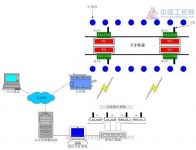
Application of wireless data transmission in steel production logistics tracking system
[ad_1]
I. Introduction:
The logistics tracking of steelmaking production refers to an extended generalized tracking system that tracks and counts the consumption of molten iron, scrap, auxiliary materials, alloy materials required for steelmaking production, as well as the output of each furnace, and the casting time of each continuous caster. It can also contain a variety of thermal signal acquisition.
In response to the above systems, Shijiazhuang Brocade Measurement and Control Technology Co., Ltd. and Beijing Jiemai Communication Equipment Co., Ltd. jointly developed a wireless steelmaking production logistics tracking system. This system has been successfully applied in the steelmaking plant of Fujian Sangang Group.
2. System objectives:
(1) Accurate, timely tracking and statistics of the consumption of various raw materials and product output in steelmaking production.
(2) Real-time tracking of crane behavior throughout the entire process, assisting in scheduling and commanding production.
(3) The investment has reached the lowest domestic level in the same system, and the technical level has reached the domestic leading level.
3. System composition:
The crane has sub-sites to complete position recognition, weight detection and ground station wireless communication (communication distance is 200 meters); the monitoring computer is set as the main site, responsible for wireless network management, behavior identification, data recording, and query reports. The computer at the main site realizes resource sharing with factory leaders and related departments through a wired network.
Schematic diagram of overall composition:

Schematic diagram of the acquisition and tracking system:

4. Working principle:
This system uses radio frequency identification detection technology and wireless transmission technology to realize the functions of this system.
Radio frequency identification (Radio frequency identification, hereinafter referred to as RFID) technology is a new type of automatic identification technology that emerged in the 1990s. Its outstanding advantage is the use of radio frequency for non-contact identification without exposed electrical contacts and electronic tags The chip can be packaged according to different application requirements, can withstand various harsh environments, and can simultaneously identify multiple electronic tags and high-speed moving electronic tags to complete multi-target recognition.
A typical RFID system consists of electronic tags (Tag), readers (Read/write Device), and data exchange and management systems.
The internal structure diagram of the reader and electronic tag is as follows:

Internal structure diagram of reader and electronic tag
A typical electronic tag is a passive system, that is, the electronic tag does not contain a battery. The energy of the electronic tag is provided by the radio frequency pulse sent by the reader. The electronic tag receives the radio frequency pulse, rectifies and charges the capacitor, and the capacitor voltage is stabilized Then it is used as the working voltage to supply power for the electronic tag. The data modulation part demodulates the data from the received radio frequency pulse and sends it to the control logic. The control logic receives instructions to complete storage, sending data and other operations. EEPROM is used to store the fixed address of the electronic tag and other user data.
According to the requirements of the crane monitoring accuracy, place electronic tags at a certain interval (such as one meter, two meters) along the crane track; bury the electronic tags separately at the representative locations of key equipment such as steelmaking furnaces and continuous casting machines, and place them on the crane The identification device is installed in the corresponding position, and all buried electronic tags are stored with unique address codes. When the vehicle passes by or arrives at the buried electronic tag position, the on-board barcode reader reads the tag address code and packs it together with the weight data It is transmitted to the main site through the wireless data transmission module.
The wireless data transmission module uses the D21DL (500mw) of Jiemai Communication, a total of four groups, two for each group, each group uses a different channel, and the channel interval is 1MHz.
5. System function:
1. Dynamically detect the position of the crane during the whole process, receive the weight data of the crane in real time, and accurately identify the behavior of the crane. The animation simulates the operation of field equipment to indicate the behavior of the crane. Record the tare and gross weight of the molten iron scale and scrap steel scale; automatically calculate the net weight. And record the steel output of each furnace; the ladle weight, gross weight, slag weight, source, destination, etc. of the molten steel to the continuous casting machine.
2. Compare the production plan with the actual recorded weight, time, and location, and evaluate the quality of the execution plan.
3. Realize image and data resource sharing through the computer network in the factory. The factory leaders and related management personnel can easily obtain the data they care about, and can view the production and operation status of the crane in real time.
[ad_2]



